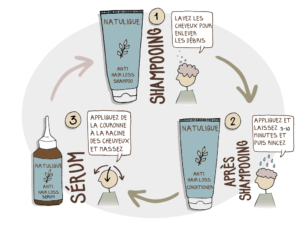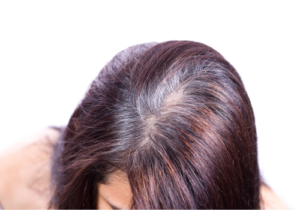Introduction to shampoo-free hair washing
The "no-poo" trend - washing hair without shampoo - is gaining in popularity. Many people want to reduce their consumption of chemicals and adopt a more natural approach to hair care. But is washing hair without shampoo really beneficial?
Why should you consider washing your hair without shampoo?
Potential dangers of certain shampoos
Many commercial shampoos contain sulfates, parabens and other chemicals that can irritate the scalp, cause allergic reactions and even damage hair structure in the long term. These components aim to remove all the hair's natural oils, which can lead to excessive dryness and over-stimulation of the sebaceous glands.
The build-up of these chemicals not only irritates the scalp, but can also be washed into water systems, where they have deleterious effects on aquatic life. Opting for a shampoo-free wash helps avoid these undesirable effects.
The environmental benefits of shampoo-free washing
As part of an ecological approach, reducing the use of hair care products also means reducing the number of plastic bottles in our landfills and in the ocean. On the other hand, avoiding polluting water with chemicals contained in shampoos is an important aspect of a more environmentally-friendly lifestyle.
Adopting a shampoo-free skincare protocol is therefore beneficial, not only for our personal health, but also for that of the planet.
Understanding the transition to shampoo-free hair washing
What happens when I stop shampooing?
Stopping to use shampoo can put your scalp into "reset" mode. Initially, hair may appear greasy due to the regulation of natural oils, a reaction linked to excessive sebum production encouraged by conventional shampoos. Eventually, this production balances out, leaving hair soft and less greasy.
Realistic transition expectations
It's crucial to prepare mentally and physically for this transition. Hair will go through an adaptation phase that may last several weeks. During this period, natural oils will gradually take over, which can make hair oily or heavy. Patience is the key to reaping the long-term benefits of non-shampooing.
Choosing to wash your hair without shampoo can be a transformative experience for your scalp and hair care habits. This approach, while a little disconcerting at first, promotes a more conscious, minimalist lifestyle, capturing the essence of natural beauty.

Different ways to wash hair without shampoo
Use of water only
The water-only washing technique
Using only water to wash your hair means doing without any cleansing products at all. The method requires you to gently massage your scalp and hair with warm water. This process helps to remove dirt and excess sebum while stimulating the hair follicles through massage. After rinsing with warm water, cold water can be used to close cuticles and leave hair shiny.
The advantages and challenges of this method
The advantages of this method include reduced scalp irritation and total respect for the natural balance of hair oils. This process is also the most economical and ecological, requiring no additional products. However, the challenges lie in the patience and time needed for your hair to get used to it, as well as in managing periods when your hair may appear greasier at the start of the process.
Using baking soda and cider vinegar
How to prepare and use this blend
Baking soda and cider vinegar are often used as a natural alternative for cleansing hair. To prepare this mixture, dissolve one or two tablespoons of baking soda in a cup of warm water. Gently apply this mixture to your roots, leave for a few minutes, then rinse thoroughly. Next, mix two to three tablespoons of cider vinegar with a cup of water, pour over your hair to balance the pH, and rinse.
The advantages and challenges of this method
This process effectively cleanses the scalp, removing oil residues and impurities without over-drying the hair. Cider vinegar adds shine and softness to hair. However, proportions should be adapted to your hair type to avoid drying out or irritation caused by excessive use of bicarbonate. Initial trials may require a few adjustments to identify what works best for you.
Using ayurvedic powders
Which powders to use and how to apply them
Ayurvedic powders such as shikakai, bhringraj, amla and reetha are traditional hair care products in India. To prepare a hair cleanser, mix your chosen powder with lukewarm water until you obtain a paste. Apply to scalp and hair, leave on for a few minutes, then rinse thoroughly. These powders are rich in nutrients that nourish hair follicles.
The advantages and challenges of this method
Ayurvedic powders are natural and offer a variety of benefits depending on your selection, from reducing dandruff to promoting hair growth. They are beneficial for strengthening hair and improving its texture. However, some of these powders can be difficult to source depending on your location, and their preparation can be more time-consuming than using prefabricated products. New users will need to test several formulas to find the one that optimizes results.
See also: How do I bleach my hair brown?
Tips for a smooth transition to shampoo-free hair washing
Adapt your hair routine for a gentle change
Gradually reduce shampoo use
- For those who regularly use conventional shampoos, gradually reducing the frequency of use can help avoid a shock to the scalp. Start by spacing out shampoo washes to once a week before abandoning them altogether.
- Replacing shampoo with alternative methods every other day can also help the scalp adapt more smoothly to the new chemical-free routine.
Identify your hair type to choose the right method
- Each hair type reacts differently depending on the method adopted. Understanding your hair type, whether oily, dry or normal, can guide your choice of method, whether it's a simple water rinse, the use of baking soda, or Ayurvedic powders.
- Curly or thick hair may need more moisturizing care, while fine hair may be more sensitive to drying products like bicarbonate.
Listen to your scalp
- During the transition, listening to your scalp's needs is essential. Excessive itching or dryness may indicate that your chosen method is not suitable, and that an adaptation is necessary.
- Adjusting the frequency of washing or alternating with cider vinegar rinses can help restore balance to the scalp.
Hair care and moisturizing
Use of natural oils
- Regular application of natural oils such as coconut oil, argan oil or jojoba oil can help to deeply nourish hair and maintain its hydration, especially during the first few weeks of the transition.
- These oils can be used as an oil bath before washing, or as a leave-in treatment on the ends to prevent breakage.
Regular brushing and scalp massage
- Opting for a brush with natural bristles helps distribute the scalp's natural oils evenly throughout the hair, enhancing their protective action and shine.
- Massaging the scalp regularly to stimulate blood circulation also helps maintain hair health and encourage healthy growth.
Practical tips for a successful no-poo method
Patience and perseverance
- Adapting to a shampoo-free hair routine takes time. Although positive results can take weeks to appear, patience is crucial to overcoming the initial discomfort.
- Keeping a hair diary can be useful for noting changes in hair texture and health, allowing you to better adjust your hair routine along the way.
Take advantage of community advice
- Joining groups or forums dedicated to no-poo allows you to benefit from the experience of others who have taken the plunge. Exchanging tips and recommendations can enrich your personal approach.
- Don't hesitate to try out different methods and combinations of natural ingredients to find what works best for you, taking into account the specificities of each individual.

Common mistakes and how to avoid them in shampoo-free hair washing
Why can the shampoo-free approach fail?
Incorrect use of natural ingredients
Many people new to the no-poo method tend not to follow the recommended amounts of natural ingredients like baking soda or cider vinegar. Excessive or too-frequent application can unbalance the scalp, causing irritation or dryness. It's essential to respect the right proportions and frequency for each hair type to ensure optimal balance.
Lack of patience during the transition
The transition phase without shampoo can be frustrating. Many people expect instant results and may give up prematurely. The key is to understand that every scalp reacts differently and often requires several weeks to adjust. Holding out during this period increases the chances of success and of achieving healthy hair the natural way.
Optimize your hair routine
Avoid overcompensating with alternative products
In the desire to avoid chemicals, some people are quick to turn to a multitude of natural products. It's crucial not to overload the hair with too many treatments at the risk of creating an imbalance. The watchword is simplicity: choose one or two natural ingredients appropriate to your hair type and observe how they react over time.
Maintaining a balanced diet
One aspect of hair care that is often overlooked is nutrition. A balanced diet has a direct influence on hair health. Eating foods rich in vitamins, minerals and essential fatty acids helps nourish the scalp from within, encouraging healthy, shiny hair.
FAQ
Is shampoo-free washing suitable for all hair types?
Yes, but it's crucial to adapt the method you choose to your hair type. Each type will react differently, so it may be necessary to experiment to find what works best for you.
How long does it take for my hair to adapt to the no-poo method?
On average, it takes two to six weeks for the scalp to fully adapt to the no-poo method. This may vary according to the individual and his or her previous habits.
How do you manage itching during the transition phase?
Itching can occur due to sebum build-up. Regular brushing with a natural bristle brush can help distribute oils evenly and reduce this discomfort.
Can I combine several shampoo-free washing methods?
Yes, it's possible to combine different methods, such as alternating between water only and a cider vinegar solution, depending on your needs and how your hair reacts.
Does not using shampoo affect hair volume?
At first, hair may appear flatter due to the accumulation of natural oils. However, once balanced, hair often regains its natural volume, sometimes even improving it.





